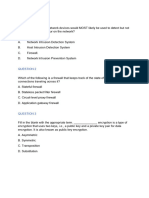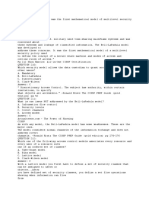0 ratings0% found this document useful (0 votes)
46 viewsSecurity Part 3
Monitoring electromagnetic signals from computers can provide hackers an advantage by allowing undetectable active monitoring of systems. Specifically known as TEMPEST, the study aims to prevent intruders from intercepting emissions and gaining sensitive information without direct access. Fiber optic cables are the most resistant medium to such tapping due to transmitting data as light pulses rather than electrical signals.
Uploaded by
kassahunCopyright
© © All Rights Reserved
Available Formats
Download as DOCX, PDF, TXT or read online on Scribd
0 ratings0% found this document useful (0 votes)
46 viewsSecurity Part 3
Monitoring electromagnetic signals from computers can provide hackers an advantage by allowing undetectable active monitoring of systems. Specifically known as TEMPEST, the study aims to prevent intruders from intercepting emissions and gaining sensitive information without direct access. Fiber optic cables are the most resistant medium to such tapping due to transmitting data as light pulses rather than electrical signals.
Uploaded by
kassahunCopyright
© © All Rights Reserved
Available Formats
Download as DOCX, PDF, TXT or read online on Scribd
You are on page 1/ 3
Monitoring electromagnetic pulse emanations from PCs and CRTs provides a
hacker with that significant
advantage?
A. Defeat the TEMPEST safeguard
B. Bypass the system security application.
C. Gain system information without trespassing
D. Undetectable active monitoring.
Answer: D
Tempest equipment is implemented to prevent intruders from picking up
information through the
airwaves with listening devices. - Shon Harris All-in-one CISSP Certification
Guide pg 192. In
Harris's other book CISSP PASSPORT, she talks about tempest in terms of spy
movies and how
a van outside is listening or monitoring to the activities of someone. This
lends credence to the
answer of C (trespassing) but I think D is more correct. In that all the
listener must do is listen to
the RF. Use your best judgment based on experience and knowledge.
QUESTION 346:
What name is given to the study and control of signal emanations from
electrical and electromagnetic
equipment?
A. EMI
B. Cross Talk
C. EMP
D. TEMPEST
Answer: D
QUESTION 347:
TEMPEST addresses
A. The vulnerability of time-dependent transmissions.
B. Health hazards of electronic equipment.
C. Signal emanations from electronic equipment.
D. The protection of data from high energy attacks.
Answer: C
"Tempest is the study and control of spurious electrical signals that are
emitted by electrical
equipment." Pg 167 Shon Harris: All-In-One CISSP Certification Exam Guide
QUESTION 348:
Which one of the following is the MOST solid defense against interception of a
network
transmission?
A. Frequency hopping
B. Optical fiber
C. Alternate routing
D. Encryption
Answer: B
An alternative to conductor-based network cabling is fiber-optic cable. Fiber-
optic cables
transmit pulses of light rather than electricity. This has the advantage of
being extremely fast and
near impervious to tapping.
Pg 85 Tittel: CISSP Study Guide.
QUESTION 349:
Which of the following media is MOST resistant to tapping?
A. Microwave
B. Twisted pair
C. Coaxial cable
D. Fiber optic
Answer: D
QUESTION 350:
What type of wiretapping involves injecting something into the communications?
A. Aggressive
B. Captive
C. Passive
D. Active
Answer: D
Most communications are vulnerable to some type of wiretapping or
eavesdropping. It can usually be done
undetected and is referred to as a passive attack versus an active attack. -
Shon Harris All-in-one CISSP
Certification Guide pg 649
"(I) An attack that intercepts and accesses data and other information
contained in a flow in a
communication system. (C) Although the term originally referred to making a
mechanical
connection to an electrical conductor that links two nodes, it is now used to
refer to reading
information from any sort of medium used for a link or even directly from a
node, such as
gateway or subnetwork switch. (C) "Active wiretapping" attempts to alter the
data or otherwise
affect the flow; "passive wiretapping" only attempts to observe the flow and
gain knowledge of
information it contains. (See: active attack, end-to-end encryption, passive
attack.)"
http://www.linuxsecurity.com/dictionary/dict-455.html
QUESTION 351:
Why would an Ethernet LAN in a bus topology have a greater risk of
unauthorized
disclosure than switched Ethernet in a hub-and-spoke or star topology?
A. IEEE 802.5 protocol for Ethernet cannot support encryption.
B. Ethernet is a broadcast technology.
C. Hub and spoke connections are highly multiplexed.
D. TCP/IP is an insecure protocol.
Answer: B
Ethernet is broadcast and the question asks about a bus topology vs a SWITCHED
Ethernet.
Most switched Ethernet lans are divided by vlans which contain broadcasts to a
single vlan, but
remember only a layer 3 device can stop a broadcast.
QUESTION 352:
What type of attacks occurs when a smartcard is operating under normal
physical
conditions, but sensitive information is gained by examining the bytes going
to and from
the smartcard?
A. Physical attacks.
B. Logical attacks.
C. Trojan Horse attacks.
D. Social Engineering attacks.
Answer: B
Explanation:
Logical attacks occur when a smartcard is operating under normal physical
conditions,
but sensitive information is gained by examining the bytes going to and from
the
smartcard. One example is the so-called "timing attack" described by Paul
Kocher. In
this attack, various byte patterns are sent to the card to be signed by the
private
key. Information such as the time required to perform the operation and the
number of
zeroes and ones in the input bytes are used to eventually obtain the private
key. There
are logical countermeasures to this attack but not all smartcard manufacturers
have
implemented them. This attack does require that the PIN to the card be known,
so that
many private key operations can be performed on chosen input bytes.
QUESTION 353:
What is an effective countermeasure against Trojan horse attack that targets
smart cards?
A. Singe-access device driver architecture.
B. Handprint driver architecture.
C. Fingerprint driver architecture.
D. All of the choices.
Answer: A
Explanation:
The countermeasure to prevent this attack is to use "single-access device
driver"
architecture. With this type of architecture, the operating system enforces
that only
one application can have access to the serial device (and thus the smartcard)
at any
given time. This prevents the attack but also lessens the convenience of the
smartcard
because multiple applications cannot use the services of the card at the same
time.
Another way to prevent the attack is by using a smartcard that enforces a "one
private
key usage per PIN entry" policy model. In this model, the user must enter
their PIN
every single time the private key is to be used and therefore the Trojan horse
would
not have access to the key.
QUESTION 354:
You might also like
- 100-160 Exam Dumps - Cisco Certified Support Technician (CCST) CybersecurityNo ratings yet100-160 Exam Dumps - Cisco Certified Support Technician (CCST) Cybersecurity19 pages
- Eccouncil: Ec-Council Certified Network DefenderNo ratings yetEccouncil: Ec-Council Certified Network Defender9 pages
- CEH Exams: 312 - 50v10 Passing Score: 800 Time Limit: 120 MNNo ratings yetCEH Exams: 312 - 50v10 Passing Score: 800 Time Limit: 120 MN10 pages
- CSE 410 - Intro To Computer Security Practice MidtermNo ratings yetCSE 410 - Intro To Computer Security Practice Midterm2 pages
- Pass4Test: IT Certification Guaranteed, The Easy Way!No ratings yetPass4Test: IT Certification Guaranteed, The Easy Way!5 pages
- Question Bank For (ICS) : Information and Cyber SecurityNo ratings yetQuestion Bank For (ICS) : Information and Cyber Security29 pages
- Hide Answer Workspace: A. Phishing B. Bulling C. Stalking D. Identity TheftNo ratings yetHide Answer Workspace: A. Phishing B. Bulling C. Stalking D. Identity Theft23 pages
- Top Ethical Hacking Questions and Answers: Let's Take A Look at Some of The Most Important and Frequently AskedNo ratings yetTop Ethical Hacking Questions and Answers: Let's Take A Look at Some of The Most Important and Frequently Asked12 pages
- Palo Alto PCCSA Real Exam Questions & Answers PDFNo ratings yetPalo Alto PCCSA Real Exam Questions & Answers PDF19 pages
- Computer Fundamentals Questions and AnswersNo ratings yetComputer Fundamentals Questions and Answers3 pages
- Which of The Following Is The Used To Wireless Communication ? A. STP B. Utp C. Bluetooth D. Fiber OpticNo ratings yetWhich of The Following Is The Used To Wireless Communication ? A. STP B. Utp C. Bluetooth D. Fiber Optic5 pages
- Comptia Security Study Questions 1722224450No ratings yetComptia Security Study Questions 1722224450238 pages
- C. Port Scanning, Banner Grabbing, Service Identification: D. IDS LogNo ratings yetC. Port Scanning, Banner Grabbing, Service Identification: D. IDS Log30 pages
- Network Security Traceback Attack and React in the United States Department of Defense NetworkFrom EverandNetwork Security Traceback Attack and React in the United States Department of Defense NetworkNo ratings yet
- How Iot Works: Industrial Internet of ThingsNo ratings yetHow Iot Works: Industrial Internet of Things4 pages
- Case Study: Medical Monitoring Devices Based On Work Done at Hewlett-Packard Patient Monitoring Division Circa 1993No ratings yetCase Study: Medical Monitoring Devices Based On Work Done at Hewlett-Packard Patient Monitoring Division Circa 199312 pages
- Protect Yourself and Others From The Spread COVID-19No ratings yetProtect Yourself and Others From The Spread COVID-192 pages
- Power Electronics Power Electronics Elektronika DayaNo ratings yetPower Electronics Power Electronics Elektronika Daya33 pages
- Quick Guide:: How To Install A Fronius Smart Meter 63A-1 and 63A-3No ratings yetQuick Guide:: How To Install A Fronius Smart Meter 63A-1 and 63A-319 pages
- SR# Call Type A Party B-Party Date & Time Duration Cell ID0% (1)SR# Call Type A Party B-Party Date & Time Duration Cell ID117 pages
- VSF Testing For 2930: Switches SW VersionsNo ratings yetVSF Testing For 2930: Switches SW Versions10 pages
- Module 1 - 8085 Microprocessor: Lecture 9 - Execution of An Instruction in and MicroprocessorNo ratings yetModule 1 - 8085 Microprocessor: Lecture 9 - Execution of An Instruction in and Microprocessor6 pages
- Rajagiri School of Engineering and TechnologyNo ratings yetRajagiri School of Engineering and Technology44 pages
- UNIT - 4 Microprocessor and Its ApplicationsNo ratings yetUNIT - 4 Microprocessor and Its Applications14 pages
- Vehicle Programming, Coding and Diagnosis For BMW Via Internet100% (1)Vehicle Programming, Coding and Diagnosis For BMW Via Internet15 pages
- LF Networking Whitepaper: Presented by The LFN Technical Advisory Council (TAC)No ratings yetLF Networking Whitepaper: Presented by The LFN Technical Advisory Council (TAC)49 pages
- 1.3.1.3 Lab - Researching Converged Network ServicesNo ratings yet1.3.1.3 Lab - Researching Converged Network Services3 pages
- Projects - IEE Feb-June 2023 - Updated FileNo ratings yetProjects - IEE Feb-June 2023 - Updated File43 pages
- User Manual: Please Read Carefully Before UseNo ratings yetUser Manual: Please Read Carefully Before Use21 pages
- Computing - EOTT - 2 - Programming RObots and SBCNo ratings yetComputing - EOTT - 2 - Programming RObots and SBC2 pages
- Experiment 9 - Performance Efficiency of Wind Charging SystemNo ratings yetExperiment 9 - Performance Efficiency of Wind Charging System4 pages
- Data Sheet: N-Channel Enhancement Mode MOS TransistorNo ratings yetData Sheet: N-Channel Enhancement Mode MOS Transistor8 pages
- En - Apec2017 3kW Interleaved Digital PFC FinalNo ratings yetEn - Apec2017 3kW Interleaved Digital PFC Final20 pages
- Notes: Sound Editing: Frequency:The Frequency Is The Number of Peaks and Troughs Per Second and Is Given AsNo ratings yetNotes: Sound Editing: Frequency:The Frequency Is The Number of Peaks and Troughs Per Second and Is Given As4 pages
- Computer_dept-Gr.8E-1st_semester-Revision_sheet(1)No ratings yetComputer_dept-Gr.8E-1st_semester-Revision_sheet(1)6 pages
















































































































